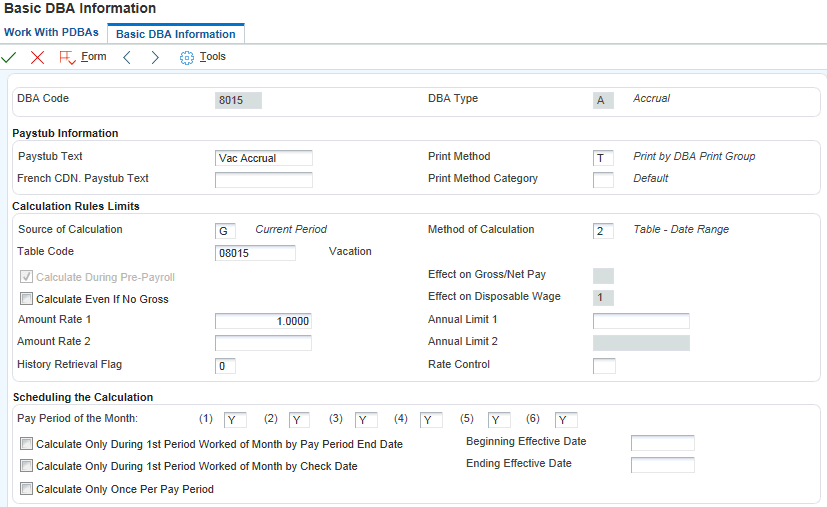Example: Vacation Rollover for Time Not Immediately Available
Your vacation policy might state that:
Employees accrue vacation time at the rate of four to 10 hours per month, based on years of employment.
Employees may take vacation time in the calendar year following the year in which it was earned.
Note:To calculate vacation or sick leave accruals in days instead of hours, you can use an alternate table method in the rollover calculation table.
To administer this vacation policy, you would set up:
A pay type (such as 815, Vacation Pay) that tracks the vacation time that an employee takes.
An accrual (such as 8015, Vacation) that tracks the vacation time that an employee earns.
The accrued time rolls over to a second DBA that tracks the available vacation time. Accrued time is not available until it rolls over.
This example shows the setup of accrual 8015:

An accrual (such as 8016, Vacation Available) tracks the vacation time that is available to the employee.
You can use the accrual rollover table associated with this second accrual to establish the limit on the number of hours that can roll over into the following year, as shown in this example:

When you set up accrual 8016, Vacation Available, you would enter this rollover information:
In the Benefit/Accrual Type field, enter V (Vacation Pay).
In the Rollover Table field, enter the table code of the rollover table that you just created so that only the specified amount rolls over.
Note:If you specify a limit in the ITD Limit field, the system ignores any table code that you might have entered in the Rollover Table field. When you specify a limit in the ITD Limit field, the system assumes that you roll over amounts only up to the maximum hours that you specified.
In the Related PDBA field, enter the number of the pay type used for vacation pay.
In the next Related PDBA field, enter the DBA number of the accrual that represents accrued but not yet available hours.
This example shows a vacation rollover with an 80 hour maximum:

When you run the rollover program, the system calculates the balance to roll over by adding the accumulated accrual amount and available balances, subtracting the vacation time that has been taken, and limiting the carryover amount, if you entered a rollover table, so that it does not exceed the amount entered in the rollover calculation table.
You cannot enter any information on the Rollover Setup Window for accrual 8015. The Rollover Setup Window is only maintained for the available accrual, 8016.